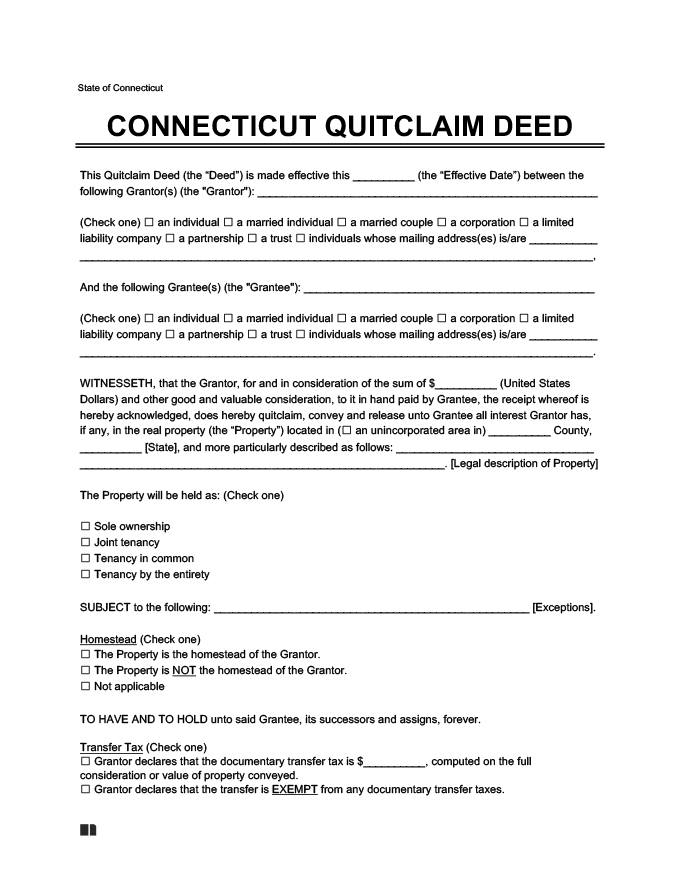In Connecticut, quitclaim deeds are used frequently to transfer property between friends and family. While these types of deeds are low in complexity, they do not protect the recipient (or “grantee”) from any issues with the current property owner’s (or “grantor’s”) claim to ownership (or “title”) on the property.
Under state law, a quitclaim deed must be in writing, contain a legal description of the property, meet specific signing and acknowledgment requirements, be notarized, be witnessed by two people, and use the correct terminology. Make sure you understand the necessary steps for legally executing this document.
Legal Framework
The laws governing quitclaim deed requirements are outlined in Conn. Gen. Stat. Ch. 821 and Ch. 821a.
Compared to other states, quitclaim deed laws in Connecticut are more straightforward. This allows grantors to fill out and file quitclaim deed forms more easily on their own while meeting the following requirements:
Legal Description
The legal description of the property does not only include its mailing address, but also further information to precisely pinpoint and identify it, outlining its dimensions and extent.
The appropriate town clerk may provide the complete legal description, or you may refer to the current property title.
Signing
- Conn. Gen. Stat. § 47-5 requires the deed to be signed by the grantor, the person transferring the property. Without their signature, the form is invalid.
- The grantor must acknowledge the deed in front of two witnesses and a notary. Under Conn. Gen. Stat. § 47-5a, the grantor can acknowledge in front of a notary public or certain other public officials, who can then count as one of the two required witnesses if this is agreed upon in advance.
Terminology
- Conn. Gen. Stat. § 47-36c provides language to use in a quitclaim deed. While not mandatory, using the statutory terminology will ensure that the quitclaim deed form is correct according to state law.
- The example language reads: “[The grantor’s name] of [the grantor’s address] for consideration paid, grant to [the grantee’s name] of [the grantee’s address] with QUITCLAIM COVENANTS.”
- Immediately following the term “QUITCLAIM COVENANTS,” include the property’s legal description, as well as any other provisions.
Additional Documents
No additional documents are required alongside a Connecticut quitclaim deed form.
Filing
- The best way to protect the transferee’s property rights is to record the deed publicly. Unless it is recorded, state law stipulates that the grantee only has rights to the property against any claims from the grantor alone.
- Counties will not typically record deeds. Instead, they should be filed in the appropriate town clerk’s office where the property is located. Office personnel will guide grantors through specific filing procedures and collect necessary fees at the time of recording.
Validity and Content Requirements
To be considered valid in the state, quitclaim deeds must contain:
- Complete information for the preparer of the document, grantor, and grantee.
- Full legal description of the property noting its location and details.
- The amount of money, if any, to be exchanged in the transfer.
- The grantor’s signature and acknowledgment from a notary and two witnesses.
Quitclaim Deeds vs. Other Property Transfer Methods
| Quitclaim Deed | Differs from other deeds in not providing the grantee with any “warranty of title.” This means that the grantee has no options for legal recourse against the grantor if it is later discovered that they did not own part or all of the property and thereby could not legally transfer it to the grantee. |
| General Warranty Deed | Provides warranty of title to the grantee. This applies to the entire timeline of the property’s existence. The language should grant “WARRANTY COVENANTS” to the grantee, per Conn. Gen. Stat. § 47-36c. |
| Limited Warranty Deed | Covers issues from a limited time within the property’s history of existence. Specifically, it only covers title issues during the time in which the owner previous to the grantee, or the grantor, owned the property in question. |
| Executor’s or Administrator’s Deed | An executor (as noted in the property owner’s will) or administrator (as appointed by the court) can handle the property’s ownership after the owner’s death. Deeds should use the language “duly qualified and authorized [executor or administrator]” and “grant with [EXECUTOR’S or ADMINISTRATOR’S] COVENANTS.” |
| Trustee's Deed | When a trust is involved in the estate planning of a property owner, handling the property after the owner’s death falls to a trustee. This trustee is the person or institution entrusted with administering the trust. Deeds should use the language “duly qualified as trustee” and “grant with TRUSTEE'S COVENANTS.” |
